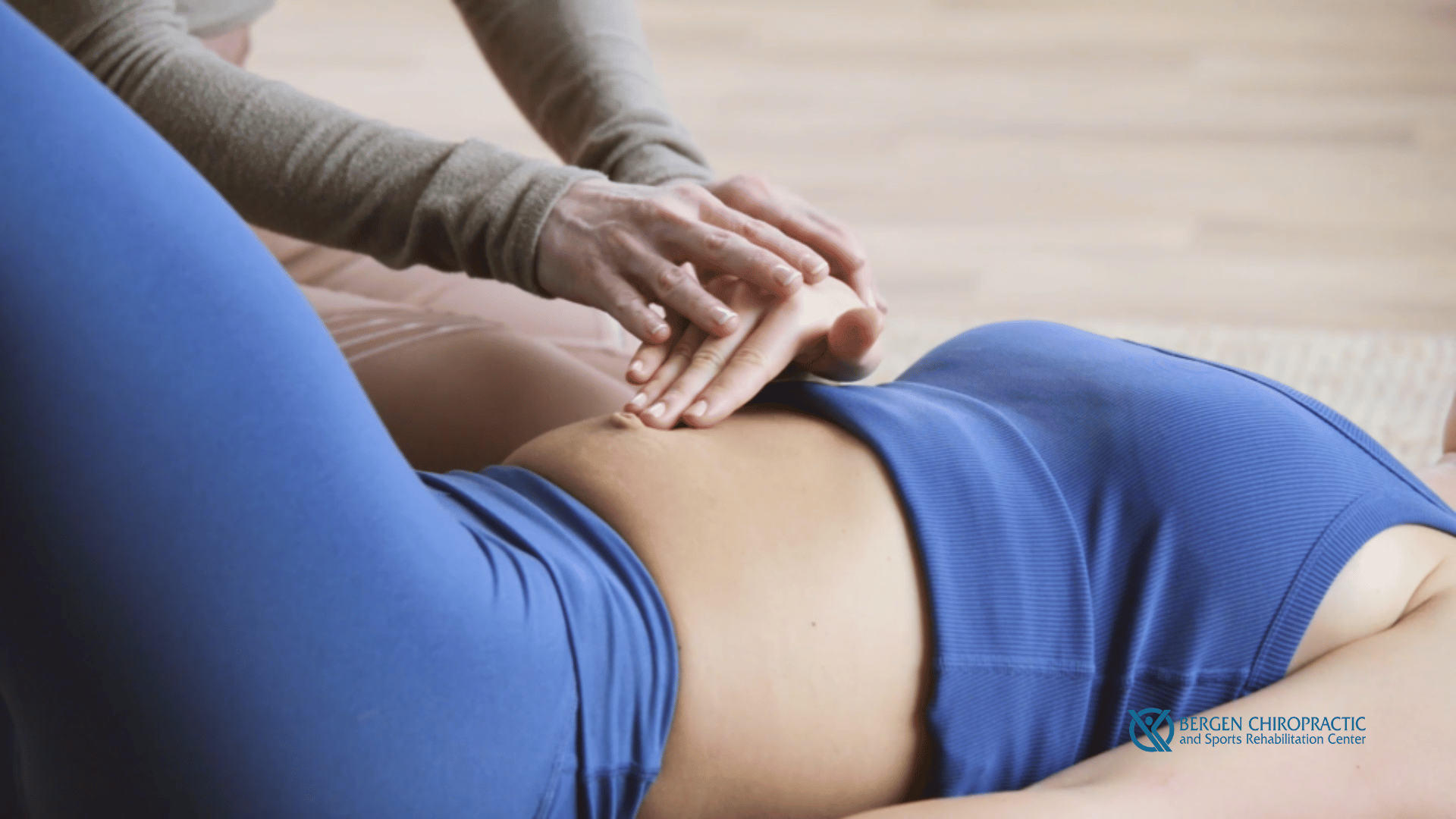Chiropractic care offers a holistic approach to addressing diastasis recti, a condition where the abdominal muscles separate.
By focusing on body alignment and muscle strengthening, chiropractic treatments improve core stability and reduce discomfort. Unlike traditional methods, chiropractic care combines gentle adjustments with tailored exercises to support healing from the inside out.
This comprehensive approach not only aids in recovery but also promotes overall well-being, making it a valuable option for those dealing with diastasis recti!
What is Diastasis Recti?
Diastasis recti is a common condition, especially among pregnant and postpartum women. Studies suggest that up to 60% of women may experience some degree of diastasis recti during or after pregnancy.
It’s not limited to women; men, children, and even newborns can develop this condition due to weight gain, heavy lifting, or genetics.
For those with diastasis recti, it often feels like a soft gap or bulge in the middle of the abdomen. Some describe a feeling of weakness or a lack of support in their core, making activities like lifting, bending, or even standing more difficult.
Many experience discomfort or pain in the lower back and notice changes in posture. Although diastasis recti is common, the good news is that with proper treatment and exercises, the muscles can be strengthened, and the gap can gradually close.
7 Common Causes of Diastasis Recti
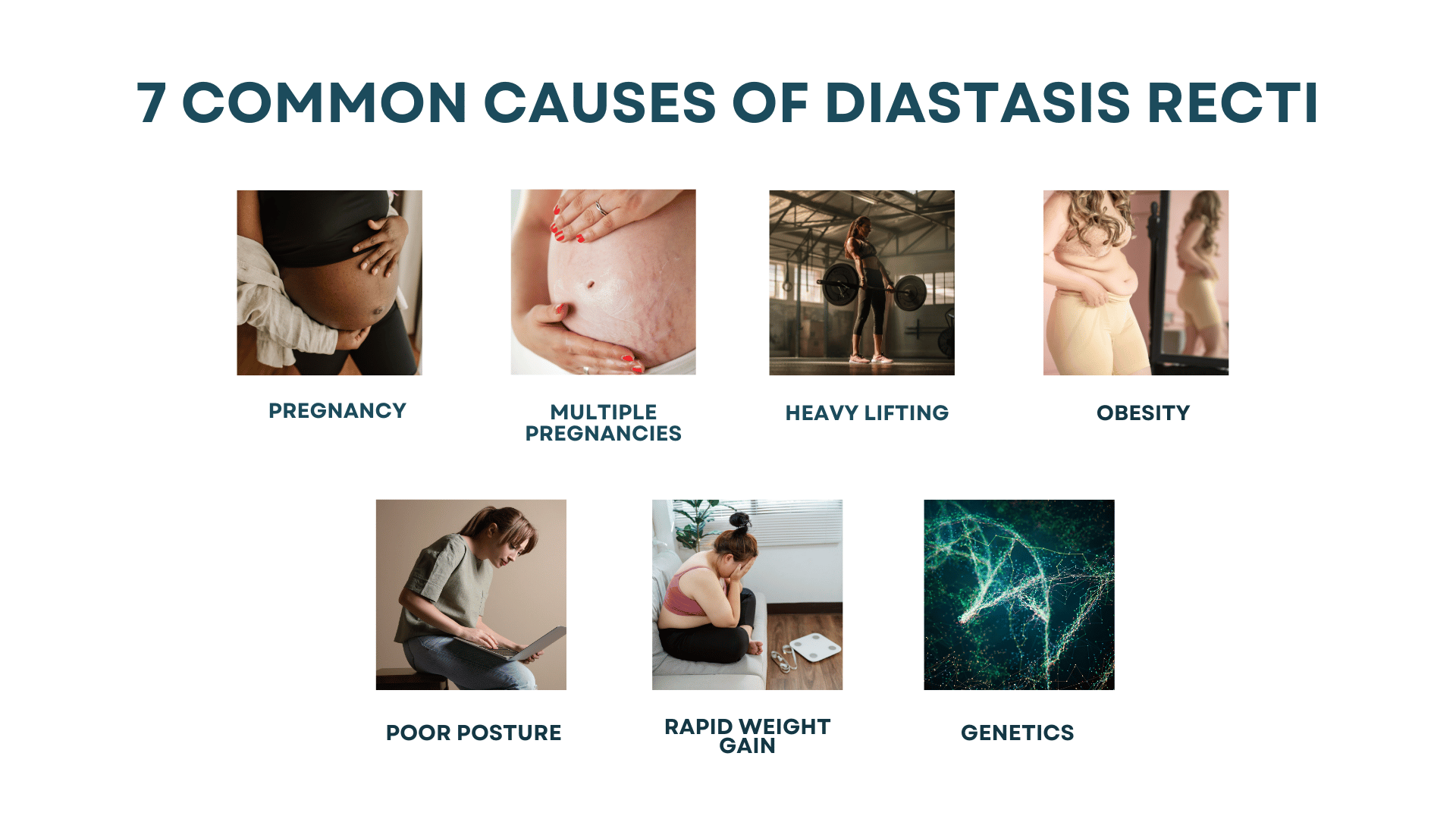
Diastasis recti is a condition that affects many people, often without them even realizing it. Understanding what causes this separation of the abdominal muscles can help you take steps to prevent or manage it:
- Pregnancy: The growing baby puts pressure on the abdominal muscles, causing them to stretch and sometimes separate.
- Multiple Pregnancies: Having more than one pregnancy, especially close together, increases the risk due to repeated stretching.
- Heavy Lifting: Lifting heavy objects improperly can strain the abdominal muscles, leading to separation.
- Obesity: Excess weight puts added pressure on the abdominal area, weakening the muscles.
- Poor Posture: Slouching or improper posture can weaken the core muscles over time, contributing to diastasis recti.
- Rapid Weight Gain: Quick weight gain can cause the abdominal muscles to stretch too quickly, leading to separation.
- Genetics: Some people are more prone to developing diastasis recti due to their genetic makeup.
6 Symptoms of Diastasis Recti
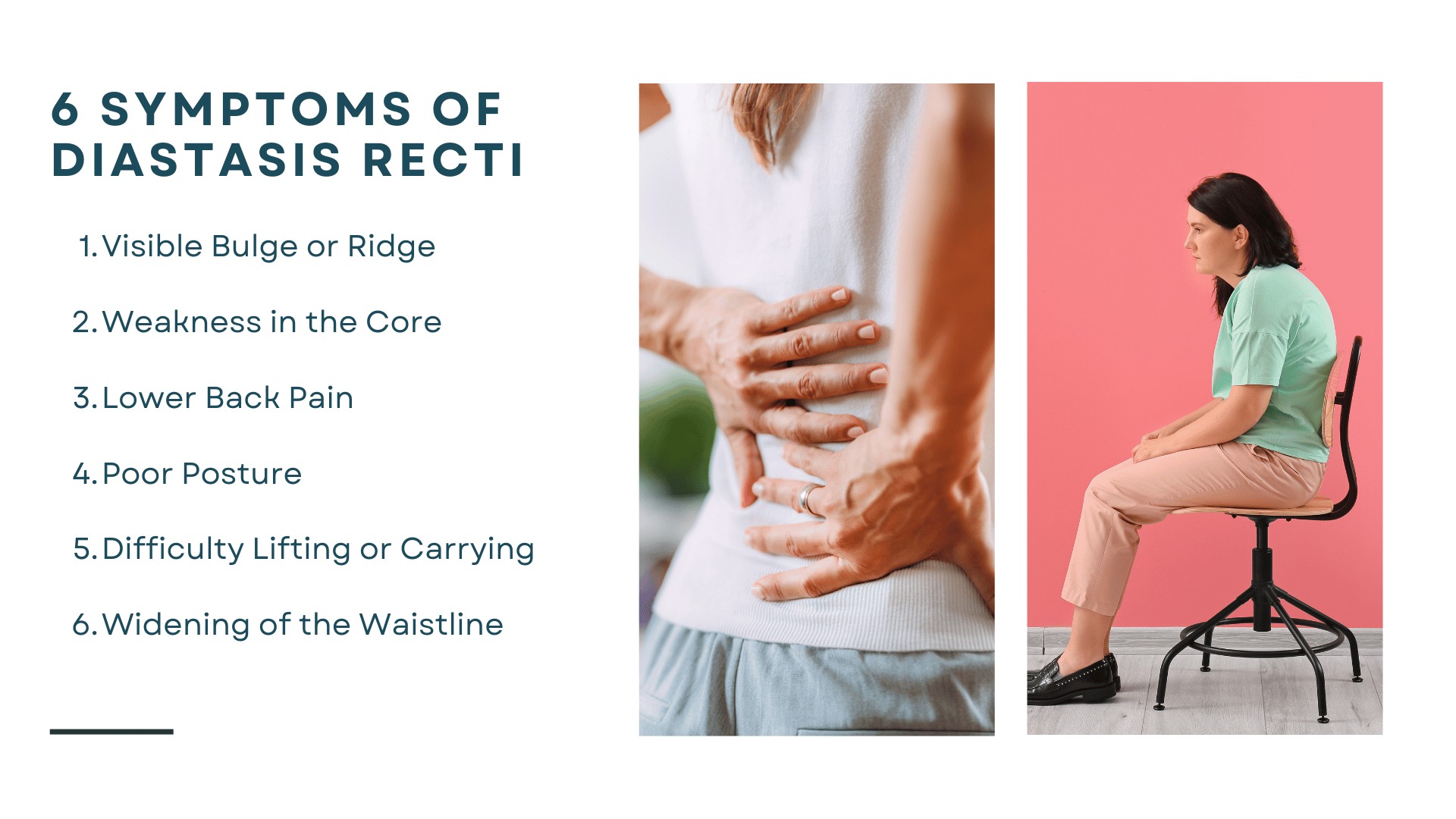
Visible Bulge or Ridge
One of the most noticeable signs of diastasis recti is a visible bulge or ridge in the middle of the abdomen. This bulge often becomes more pronounced when you engage your core muscles, such as sitting up from a lying position.
Weakness in the Core
Diastasis recti leads to general weakness in the core muscles, making it difficult to perform everyday activities, such as bending, lifting, or standing for long periods.
Lower Back Pain
The weakened core muscles associated with diastasis recti put extra strain on your lower back, leading to persistent pain or discomfort. This is a common symptom, especially when combined with poor posture.
Poor Posture
With weakened abdominal muscles, maintaining good posture can become a challenge. Many people with diastasis recti experience slouching or an uneven stance, further exacerbating back pain.
Difficulty Lifting or Carrying
Lifting or carrying objects may become challenging due to the reduced strength in your core muscles. Tasks that once seemed easy, like carrying groceries or lifting a child, become more strenuous and uncomfortable.
Widening of the Waistline
Another common symptom of diastasis recti is a widening of the waistline. It occurs as the gap between the left and right sides of the abdominal muscles increases, leading to a broader appearance of the midsection.
Who is Most at Risk for Diastasis Recti?
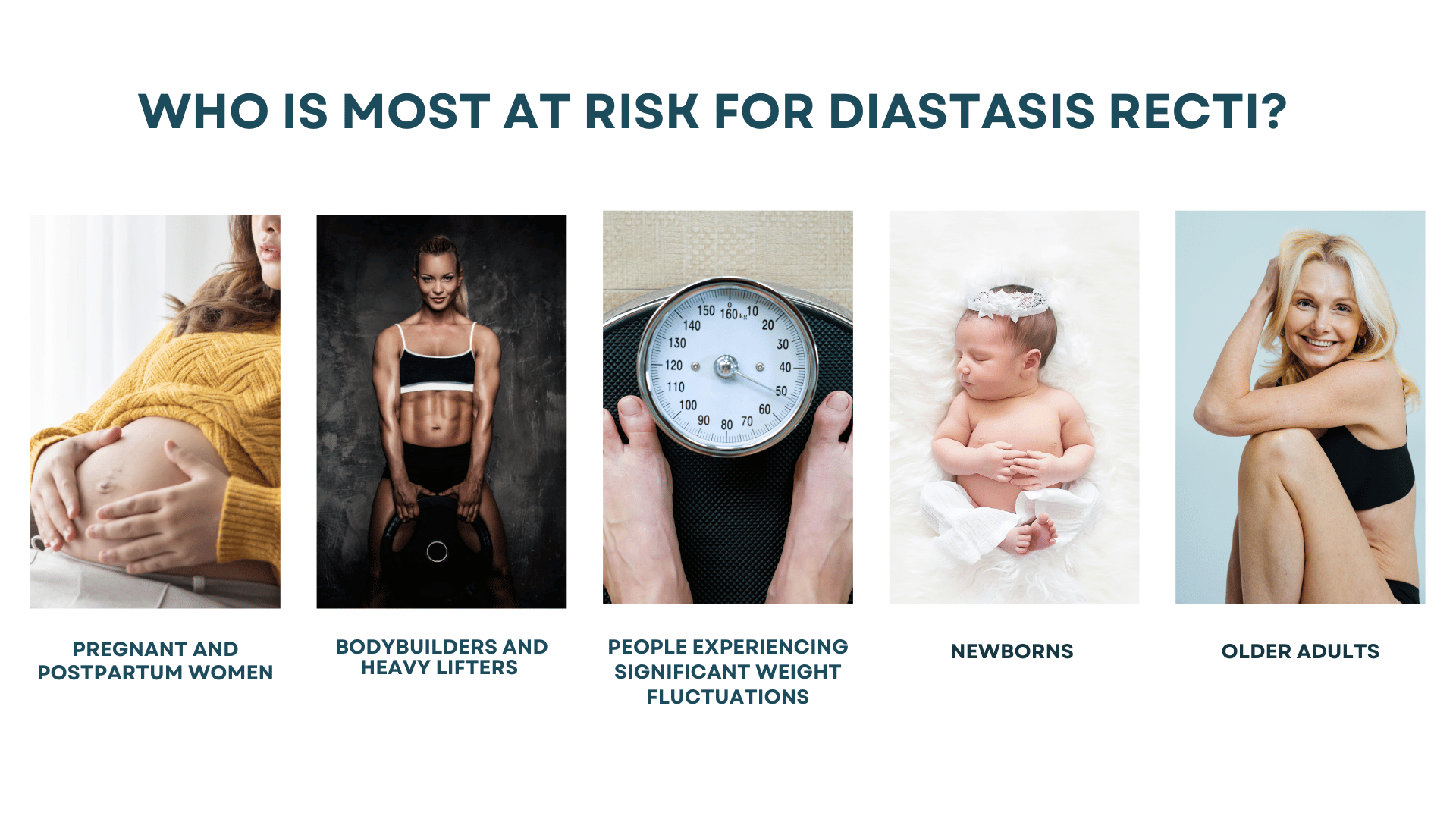
Pregnant and Postpartum Women
Pregnant and postpartum women are at the highest risk for diastasis recti. The growing baby puts pressure on the abdominal muscles, causing them to stretch and sometimes separate. After childbirth, the muscles may not return to their original position, leading to this condition.
Bodybuilders and Heavy Lifters
Improper lifting techniques and excessive strain on the core muscles can cause them to weaken and separate, resulting in diastasis recti.
People Experiencing Significant Weight Fluctuations
Rapid changes in body weight stretch and weaken the abdominal muscles, increasing the likelihood of separation.
Newborns
This condition usually resolves independently in infants as the abdominal muscles grow and strengthen over time.
Older Adults
Older adults may develop diastasis recti due to the weakening of the abdominal muscles, making them more susceptible to separation.
How is Diastasis Recti Diagnosed?
Diastasis recti is often diagnosed through a physical exam. A healthcare provider will ask you to lie on your back and lift your head slightly while they feel for a gap or bulge in your abdominal muscles. They may also measure the width of the gap to determine its severity.
In some cases, an ultrasound or CT scan may be employed to get a clearer picture of the muscle separation. These methods help physicians decide the best treatment plan to help you heal and regain your core strength.
5 Techniques Chiropractors Use to Treat Diastasis Recti
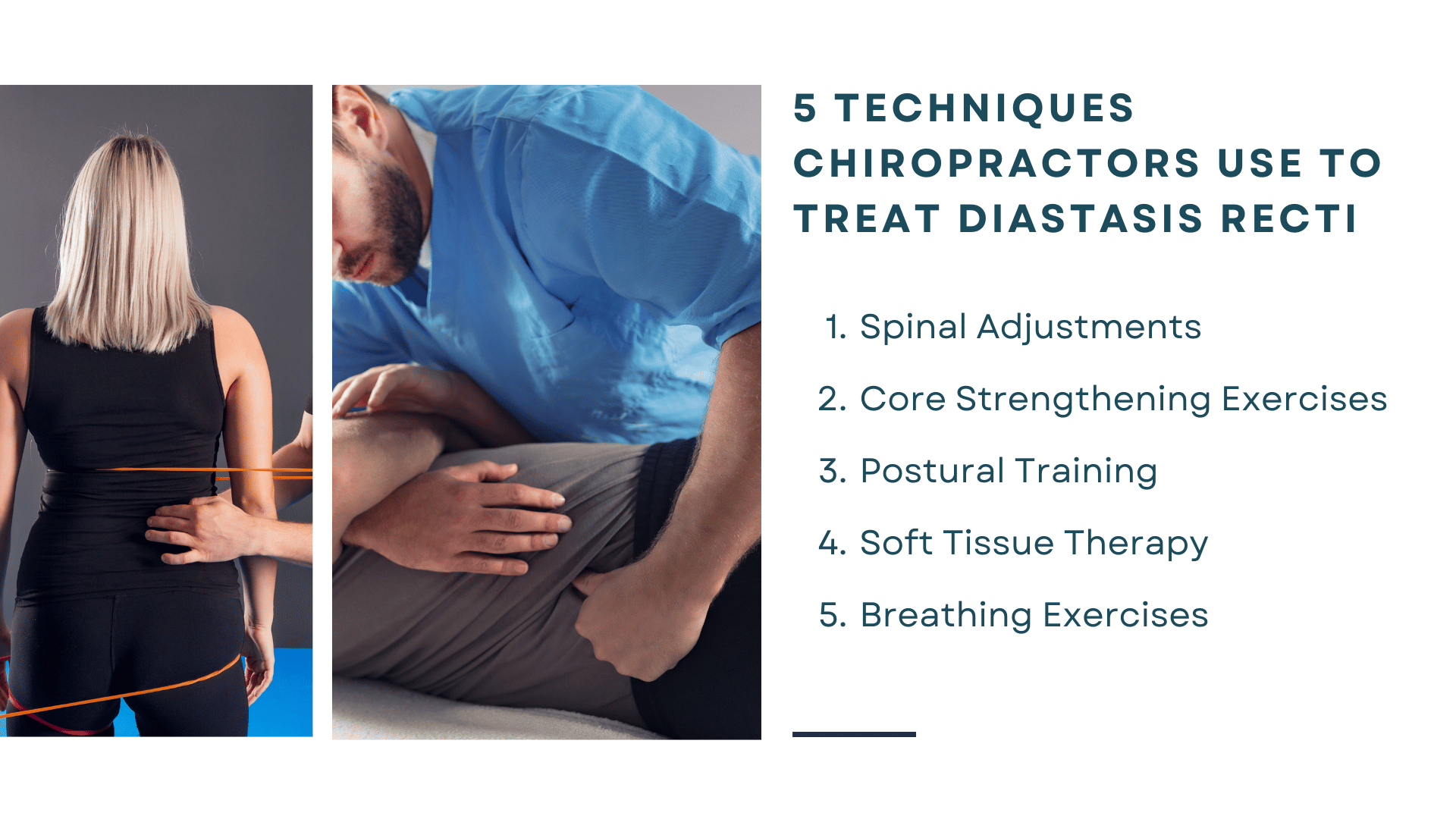
- Spinal Adjustments: Chiropractors perform gentle spinal adjustments to improve alignment and reduce pressure on the abdominal muscles.
- Core Strengthening Exercises: Specific exercises are recommended to strengthen the core muscles without putting too much strain on the separated muscles.
- Postural Training: Chiropractors improve your posture by teaching you how to stand, sit, and move in ways that support your abdominal muscles.
- Soft Tissue Therapy: Soft tissue therapy reduces muscle tension, improves blood flow, and promotes healing in the affected area by massaging and manipulating the muscles and connective tissues around the abdomen.
- Breathing Exercises: Proper breathing techniques engage the diaphragm and strengthen the core from the inside out to stabilize the abdomen and support the recovery of diastasis recti.
6 Tips to Avoid Diastasis Recti
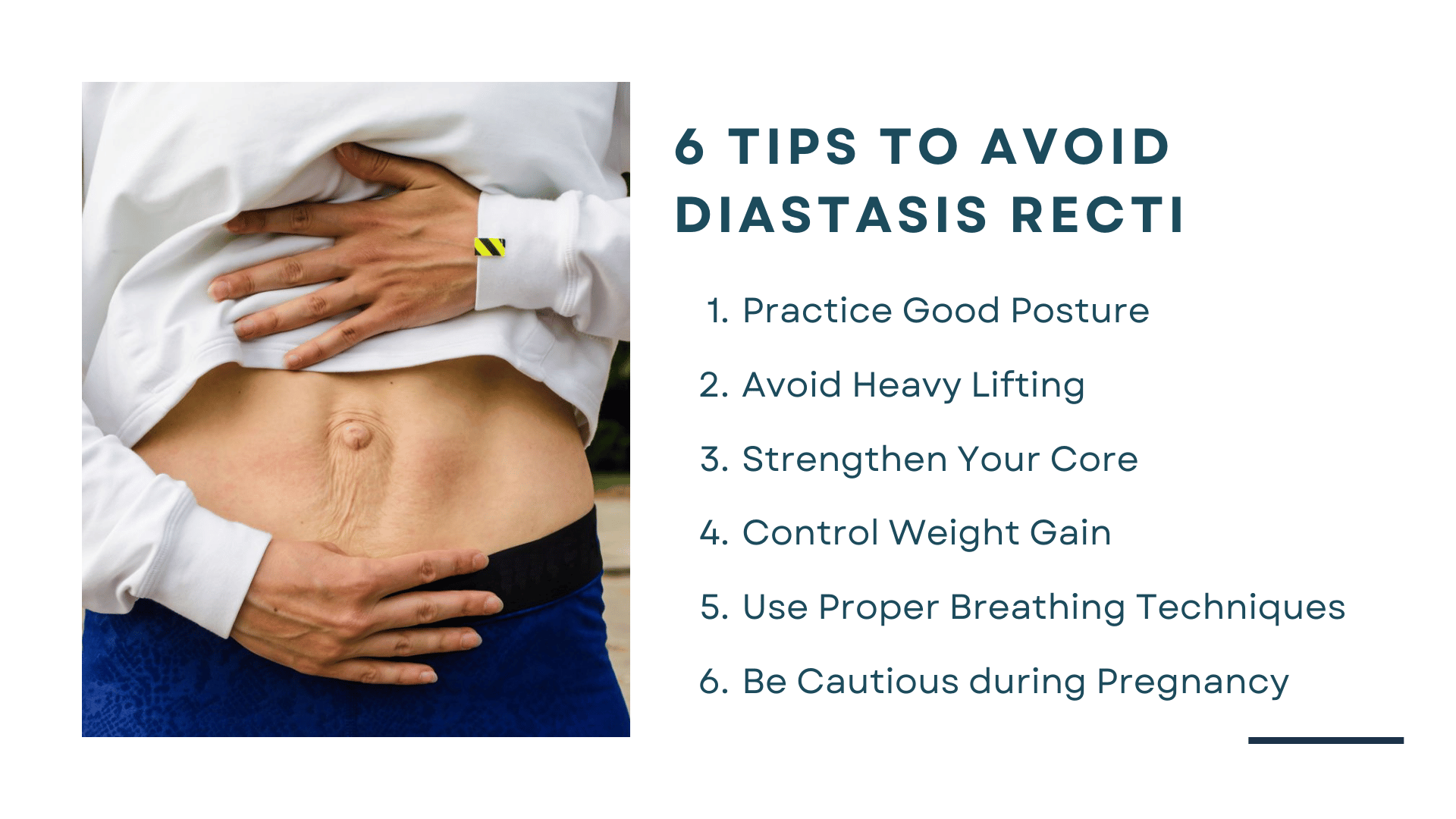
Avoiding diastasis recti involves caring for your core muscles and making mindful choices during activities:
- Practice Good Posture: Maintaining proper posture helps reduce unnecessary strain on your abdominal muscles. Stand and sit with your back straight and shoulders relaxed to keep your core engaged.
- Avoid Heavy Lifting: Always use proper form and avoid straining your core when lifting heavy objects. If possible, seek help or use tools to assist with lifting to prevent muscle separation.
- Strengthen Your Core: Engage in exercises that strengthen your core muscles, focusing on gentle movements that avoid putting too much pressure on your abdomen.
- Control Weight Gain: Keep your weight gain gradual and within healthy limits to reduce the strain on your abdominal muscles.
- Use Proper Breathing Techniques: Breathe deeply and engage your diaphragm to support your core muscles when exercising or lifting.
- Be Cautious during Pregnancy: If you’re pregnant, avoid exercises or movements that put excessive pressure on your abdomen, such as heavy lifting or intense abdominal workouts. Wearing a support belt will help alleviate pressure.
Don’t Let Abdominal Separation Hold You Back—Schedule Your Chiropractic Consultation Today!
If you suspect you have diastasis recti or are experiencing any of the signs mentioned, now is the time to take action. Chiropractic care offers a comprehensive, non-invasive approach to healing that can restore your strength and improve your quality of life!
The expert chiropractic team at Bergen Chiropractic and Sports Rehabilitation Center adheres to the highest medical standards to provide superior chiropractic care. Our mission is to provide unparalleled patient care in a comfortable, healing atmosphere.
Access our contact form or call us at (201) 357-6539 to learn more about our chiropractic care services! Our offices at 532 Anderson Avenue, Cliffside Park, NJ 07010, and 62 Summit Ave, Hackensack, NJ 07601, are ready to welcome you as we proudly serve the areas of New York, New Jersey, Philadelphia, PA, and Baltimore, MD. Also, access our blog, Facebook, and Instagram pages for more information on chiropractic care for diastasis recti!
References
- Laframboise, F. C., Schlaff, R. A., and Baruth, M. “Postpartum Exercise Intervention Targeting Diastasis Recti Abdominis.” International Journal of Exercise Science, vol. 14, no. 3, 2021, pp. 400–409. https://www.ncbi.nlm.nih.gov/pmc/articles/PMC8136546/. Accessed 30 August 2024.
- “The Comprehensive Approach of Chiropractic Care in Treating Sports Hernias.” PPL-AI File Upload. Accessed 30 August 2024, https://ppl-ai-file-upload.s3.amazonaws.com/web/direct-files/30068940/398f3cf5-8207-446a-98a5-dfb5bdf2fd0e/4_-The-Comprehensive-Approach-of-Chiropractic-Care-in-Treating-Sports-Hernias.docx.
- Espinosa Family Chiropractic. “Diastasis Recti.” Espinosa Family Chiropractic, https://www.espinosafamilychiropractic.com/diastasis-recti/. Accessed 30 August 2024.
- Khokhar, Aamir, et al. “Diastasis Recti: Clinical and Functional Outcomes Following Physical Therapy.” Pakistan Journal of Medical Research, vol. 60, no. 4, 2021, pp. 221-227. https://www.pjmr.org.pk/index.php/pjmr/article/view/221. Accessed 30 August 2024.
- Alpha One Physio. “Can Physiotherapy or Chiropractic Help in the Treatment of Diastasis Recti?” Alpha One Physio, https://alphaonephysio.ca/physiotherapy/can-physiotherapy-or-chiropractic-help-in-the-treatment-of-diastasis-recti/. Accessed 30 August 2024.
- Lobo, Michelle L. “Diastasis Recti: What Is It and How Can It Be Treated?” Hospital for Special Surgery, https://www.hss.edu/article_diastasis-recti.asp. Accessed 30 August 2024.
- Ribeiro, Ana Lúcia, et al. “Effectiveness of a Rehabilitative Exercise Program in the Treatment of Diastasis Recti.” Fisioterapia em Movimento, vol. 32, no. 1, 2019, https://www.scielo.br/j/fm/a/m3kY9XFcxRq4pGKkQfXkYXF/. Accessed 30 August 2024.
- Zheng, Bo, et al. “Research on Abdominal Separation and Abdominal Wall Dysfunction: Clinical Results and Imaging Features.” Quantitative Imaging in Medicine and Surgery, vol. 11, no. 2, 2021, pp. 55762. https://qims.amegroups.org/article/view/55762/html. Accessed 30 August 2024.
- Candido, Gregory, et al. “Diastasis Recti Abdominis: A Review of Treatment Methods.” Journal of Physical Therapy Science, vol. 33, no. 1, 2021, pp. 12-18. https://www.ncbi.nlm.nih.gov/pmc/articles/PMC8721020/. Accessed 30 August 2024.
- Benjamin, David R., et al. “The impact of exercise and other physical modalities on the recovery of diastasis recti abdominis in postpartum women: A systematic review.” British Journal of Sports Medicine, vol. 50, no. 17, 2016, pp. 1092-1099. https://bjsm.bmj.com/content/50/17/1092. Accessed 30 August 2024.

